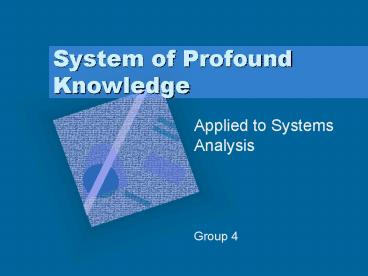System of Profound Knowledge - PowerPoint PPT Presentation
1 / 25
Title:
System of Profound Knowledge
Description:
All parts of Deming's System of Profound Knowledge can be found in and applied ... Developers provide for adequate training to avoid alienating workers ... – PowerPoint PPT presentation
Number of Views:1303
Avg rating:3.0/5.0
Title: System of Profound Knowledge
1
System of Profound Knowledge
- Applied to Systems Analysis
- Group 4
2
Systems Development Life Cycle (SDLC)
- The SDLC has four stages
3
Examples of SDLC in System of Profound Knowledge
- All parts of Demings System of Profound
Knowledge can be found in and applied to the
Systems Development Life Cycle. - The following are examples of how the System of
Profound Knowledge can be applied to the Systems
Development Life Cycle.
4
System Life Cycle vs. System of Profound Knowledge
- Appreciation for a system
- Understanding of Psychology
- Theory of Knowledge
- Theory of Variation
5
Appreciation for a System
6
Appreciation for a System
- Dr. Demings appreciation for a system most
closely matches systems analysis in the Systems
Development Life Cycle.
7
Appreciation for a System
- Requires understanding of how the current system
works. - Requires understanding of how a sub-system fits
into the big picture of a companys system.
8
In Systems Analysis We
- Study current business and information systems.
- Define requirements of the new system.
9
To Incorporate Demings System of Profound
Knowledge with Systems Analysis
- We must think outside of the actual scope of the
project to see how any changes will affect the
big picture.
10
Understanding of Psychology
11
Understanding of Psychology
- Understanding of psychology is needed because we
deal with people. - It is important that when designing a product,
this product should meet the standards the
clients are looking for and also to be delivered
to them in time. This will affect the psychology
of the clients whether to accept the product or
not.
12
Understanding of Psychology
- There are three types of motivation intrinsic,
extrinsic and over-justification. - Intrinsic motivation This is the type of
motivation that comes from within people. - Extrinsic motivation This type of motivation is
from external factors. - Over-Justification Means receiving extrinsic
rewards for something you would do anyway out of
intrinsic interest undermines intrinsic interest.
It will destroy intrinsic motivation. - Intrinsic motivation, extrinsic motivation and
over justification can affect how a company will
do the work, whether to improve its products or
not.
13
Theory of Knowledge
14
Theory of Knowledge
- The Theory of Knowledge from Dr. Demings System
of Profound Knowledge, instructs us that - A thousand facts cannot prove a theory, but one
fact can disprove a theory. - Knowledge is incomplete without a complete
understanding of the system and the environment
it is in. - There is no such thing as a True Value. There
exists only the results of a procedure. - The most important values are unknown and
unknowable. What is the cost of a disgruntled
employee?
15
System Implementation
- Demings Theory of Knowledge has been
incorporated into the SDLC, and can be seen in
System Implementation - Companies implement system changes after
predicting the likely reaction of employees - Many companies plan for resistance and develop
programs to make transition smoother - Unknown costs are given consideration
- Developers consult end users to ensure that
interface is appropriate - Developers provide for adequate training to avoid
alienating workers - System environment is studied prior to
implementation - Planning is done prior to implementation
16
Theory of Variation
17
Theory of Variation
- Within the Systems
- Development Life Cycle, the
- Theory of Variation takes on
- two personae
18
Personae of Variation
Testing
Maintenance
19
What ISD Directors Need to Know
- Variation within the two personae will occur.
- Variation can be recognized and perhaps
controlled. - Failure to notice variation will cause more
variation.
20
Sources of Variation
Documentation
Measurement Methods
Tools
Process
Input
Output
Raw Data
Human Inspection
Users
Methods
21
Summary
- Appreciation for a System
- Emphasizes the need for managers to understand
the relationships between functions and
activities. - Organizations are interactive systems and must be
managed as systems. - Other examples of how this applies to the SDLC
- Testing
- What are the overall effects of improving one
part of the system? - All parts work in conjunction with each other.
22
Summary
- Understanding of Psychology
- It is necessary to understand human interactions
through intrinsic and extrinsic motivation. - Managers must recognize that people are different
and they will interact differently with the same
system. - Other examples of how this applies to the SDLC
- Implementation
- Will users need motivation for the system?
- Is the system easy to use?
- Will users fear it?
23
Summary
- Theory of Knowledge
- All plans require prediction based on past
experience. An example of success cannot be
successfully copied unless the theory is
understood. - A systematic approach to learning will enable
individuals to develop their own theories for
continual improvement processes. - Other examples of how this applies to the SDLC
- Analysis
- Prediction is analysis - What happened before?
Why? - What should be changed?
- Create theories and modify as needed
24
Summary
- Theory of Variation
- In order to have effective leadership, it is
necessary to recognize the two personae of
variation. - Variation exists in all systems - and it exists
to improve the system. - Other examples of how this applies to the SDLC
- Design
- By understanding causes of variation in the
design phase, variation sources can be controlled
and in some cases eliminated.
25
Summary
- All four stages of the SDLC are inter-related
- All four stages interact with one another
- All four stages are needed to have a complete
system































